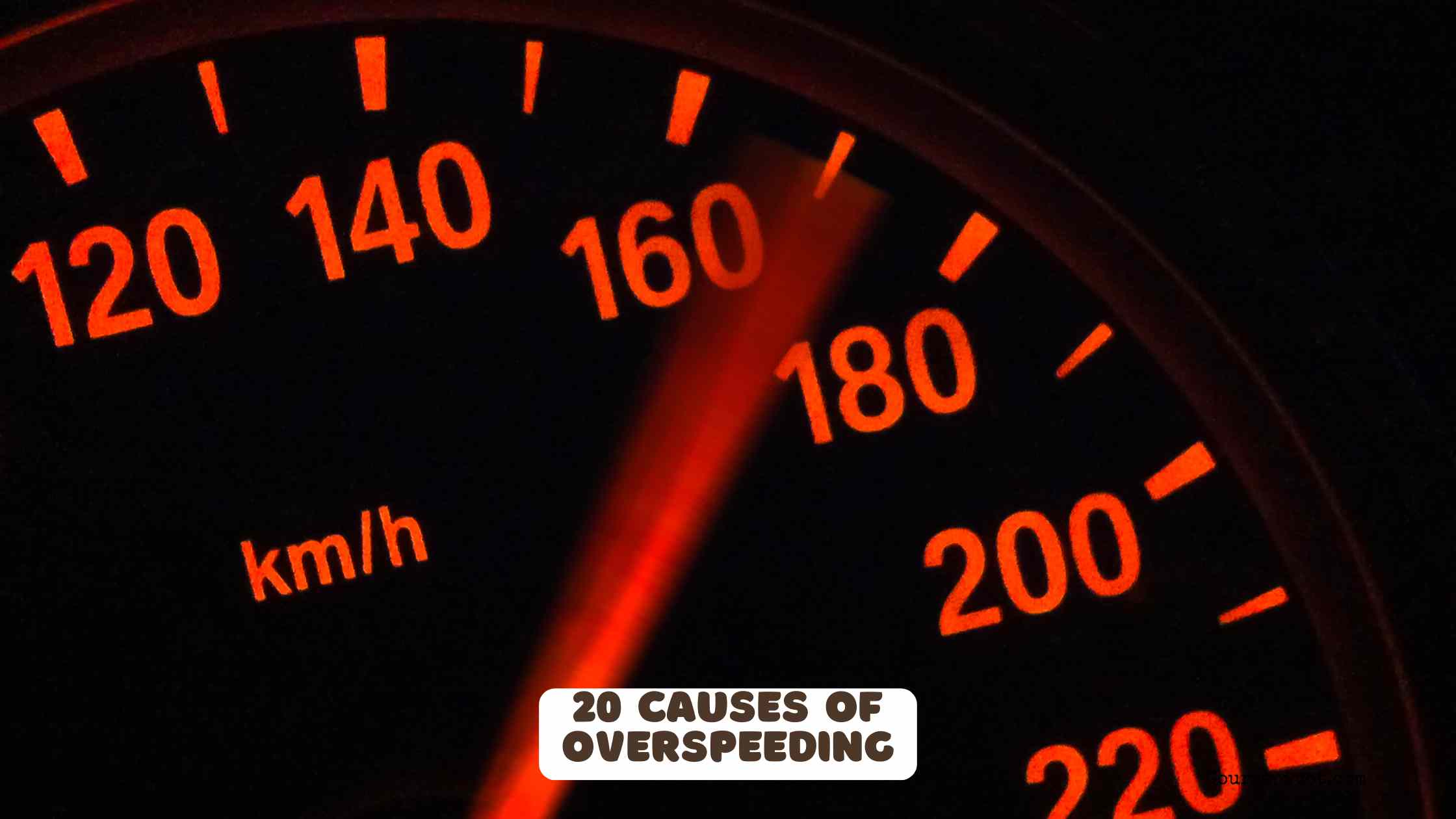
20 Causes of Overspeeding
Overspeeding, or driving above the posted speed limit, is a leading contributor to traffic accidents, claiming 11,775 lives in the U.S. in 2023 alone, according to the National Highway Traffic Safety Administration (NHTSA). That’s 29% of all traffic fatalities. Understanding 20 causes of overspeeding sheds light on why drivers push the limits and how to curb this dangerous habit. From psychological triggers to external pressures, this blog explores the root causes, backed by data, and offers practical insights to promote safer driving.
Table of Contents
Why Overspeeding Persists
Speeding isn’t just about thrill-seeking—it’s driven by a mix of personal, social, and environmental factors. In 2023, speeding contributed to 10,541 fatal crashes, with 45% of these on wet roads, showing how context amplifies the issue. By identifying these causes, drivers can recognize their own tendencies and make conscious choices to slow down. Let’s dive into the 20 causes of overspeeding and their impact on road safety.
1. Running Late
Rushing to work, school, or appointments is a top reason for speeding. Drivers often overestimate time saved, risking lives for minutes. For example, a 10-minute commute rarely shrinks significantly at 80 mph versus 60 mph.
2. Traffic Frustration
Congested roads or slow drivers spark impatience, pushing some to speed through gaps or open stretches. NHTSA notes aggressive driving, often tied to speeding, spikes crash risks by 30–50%.
3. Thrill-Seeking
Some drivers crave the adrenaline of high speeds, especially younger ones. The Governors Highway Safety Association (GHSA) links thrill-seeking to a post-pandemic surge in excessive speeding.
4. Underestimating Risks
Many believe speeding is low-risk, ignoring data like the doubling of serious injury odds at 10 mph over the limit. This misjudgment fuels reckless driving.
5. Peer Pressure
Friends or passengers urging “go faster” can influence drivers, especially teens. Social dynamics often override caution, per NHTSA’s teen driving studies.
6. Aggressive Driving Habits
Tailgating or weaving through traffic often pairs with speeding, creating a dangerous cycle. NHTSA defines these as aggressive behaviors, increasing crash likelihood.
7. Overconfidence in Skills
Drivers who overestimate their control—especially in familiar areas—speed without considering variables like road conditions. This hubris contributes to rollovers, per the Insurance Institute for Highway Safety (IIHS).
8. Poor Road Conditions
Ironically, some speed to “escape” bad conditions like rain or construction zones, unaware that 45% of speeding fatalities occur on wet roads.
9. Lack of Enforcement
Minimal police presence or lax ticketing emboldens speeding. Areas with fewer speed cameras see higher violations, per GHSA studies.
10. Cultural Normalization
When speeding is common, it feels acceptable. GHSA reports that normalized high speeds post-COVID have worsened crash severity.
11. Time Pressure from Work
Delivery drivers or those on tight schedules (e.g., rideshare) speed to meet quotas. This pressure led to a 20% rise in commercial vehicle speeding citations in 2022.
12. Distracted Driving
Phone use or in-car distractions can cause unintentional speeding, as drivers lose track of their speedometer. NHTSA links distraction to 10% of speeding-related crashes.
13. Impaired Judgment
Alcohol or drugs impair speed perception, with 30% of speeding fatalities involving alcohol, per NHTSA. Even fatigue mimics this effect, dulling caution.
14. Competitive Driving
Some drivers speed to “beat” others, treating roads like racetracks. This mindset fuels aggressive maneuvers, increasing multi-vehicle crashes.
15. Inadequate Signage
Unclear or missing speed limit signs confuse drivers, leading to unintentional speeding. Poor road design also contributes, per IIHS studies.
16. Vehicle Performance
High-performance cars tempt drivers to test limits. Sports car owners are 20% more likely to speed, according to 2023 traffic data.
17. Habitual Behavior
Chronic speeders develop a habit, ignoring limits as routine. Repeat offenders face higher fines and suspensions in states like Georgia.
18. Emotional Stress
Anger, anxiety, or personal crises can lead to reckless speeding as an outlet. NHTSA notes emotional distress as a factor in aggressive driving spikes.
19. Misjudging Time Saved
Drivers think speeding shaves significant time, but studies show it often saves just seconds per mile. For a 10-mile trip, 80 mph versus 60 mph saves about 2 minutes.
20. Lack of Education
Many drivers don’t know speeding’s dangers—like quadrupled stopping distances at doubled speeds. Public campaigns, like NHTSA’s, aim to bridge this gap but reach only 60% of drivers.
Why These Causes Matter
These 20 causes of overspeeding—from rushing to cultural norms—explain why speeding persists despite 11,775 deaths in 2023. They highlight a mix of human behavior, societal pressures, and environmental factors. Addressing them requires awareness, enforcement, and personal responsibility to break the cycle of risky driving.
Practical Tips to Avoid Overspeeding
Here’s how to counter these causes:
- Plan ahead: Leave 10–15 minutes early to avoid rushing.
- Use tech: Apps like Waze warn of speed traps or traffic.
- Stay calm: Practice deep breathing to manage frustration or stress.
- Educate yourself: Read NHTSA’s speeding stats to grasp risks.
- Set cruise control: Lock in the speed limit on highways.
Things to Avoid
Don’t justify speeding with “everyone does it”—it’s still deadly. Avoid distractions like phones, which lead to unintentional speeding. Don’t ignore road conditions; rain or curves demand slower speeds. Lastly, steer clear of peer pressure—your safety trumps others’ urging.
Tailoring to Your Driving
Commuters should focus on time management to avoid rushing. Young drivers need to resist peer pressure and thrill-seeking. Delivery drivers should prioritize safety over quotas. Adjust strategies to your driving context for safer roads.
Key Takeaways
The 20 causes of overspeeding—from running late to cultural norms—fuel a deadly epidemic, with speeding linked to 29% of U.S. traffic deaths in 2023. These triggers, rooted in behavior and environment, show why drivers push limits despite risks like doubled crash odds or quadrupled stopping distances. By planning ahead, using tech, and staying mindful, you can avoid speeding’s trap. Roads are for safe travel, not racing—what’s your plan to slow down?
Cite this article
You can copy and paste your preferred citation format below.
Martin, L. & Arquette, E.. (2025, October 1). 20 Causes of Overspeeding. Coursepivot.com. https://coursepivot.com/blog/20-causes-of-overspeeding/



